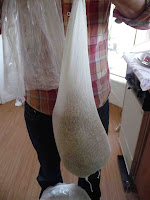 Sorry to have been dormant this last week (all 3 readers of this blog)! Last week I was in beautiful San Luis Obispo for the Cal Poly Cheesemaking Short Course. While most of the lecture was focused on cheesemaking at the plant level - plant meaning industrial, meaning coagulating 13 million gallons of milk a day, meaning Smart Car sized chunks of cheese- we did have one day of hands-on cheesemaking. Here are some pics:
Sorry to have been dormant this last week (all 3 readers of this blog)! Last week I was in beautiful San Luis Obispo for the Cal Poly Cheesemaking Short Course. While most of the lecture was focused on cheesemaking at the plant level - plant meaning industrial, meaning coagulating 13 million gallons of milk a day, meaning Smart Car sized chunks of cheese- we did have one day of hands-on cheesemaking. Here are some pics:Above we have a pasteurization system. The milk is actually pasteurized in the pipes and not the tank...
 Hair masks, perhaps a reason not to become a cheesemaker...
Hair masks, perhaps a reason not to become a cheesemaker... Cold storage of stater cultures around -45 degrees F...
Cold storage of stater cultures around -45 degrees F... One size apparently does not fit all...
One size apparently does not fit all... Measuring the stater culture. It looks like the Ice Cream of the Future, duhn, duhn, duhn...
Measuring the stater culture. It looks like the Ice Cream of the Future, duhn, duhn, duhn... Measuring the lipase. We used lipase to promote sharp flavors in the milk as we were using cow rather than the traditional goat or sheep's milk used in feta...
Measuring the lipase. We used lipase to promote sharp flavors in the milk as we were using cow rather than the traditional goat or sheep's milk used in feta...
Titratable Acidity test...
 We have achieved pink! (It's a good thing, still not grasping the TA test magic, but they tell me pink is good...)
We have achieved pink! (It's a good thing, still not grasping the TA test magic, but they tell me pink is good...) Measuring the rennet, CyroMax...
Measuring the rennet, CyroMax... We have a gel!
We have a gel! Cut feta curds...
Cut feta curds... Emptying the whey...
Emptying the whey... Filling the feta forms/hoops...
Filling the feta forms/hoops... Squeezing out more of the whey...
Squeezing out more of the whey... On to cheddar.... Stirring the milk...
On to cheddar.... Stirring the milk... After setting, the cheesemakers/students begin cutting the cheese-the term is used so much in cheesemaking and selling, it's just not funny to giggle...
After setting, the cheesemakers/students begin cutting the cheese-the term is used so much in cheesemaking and selling, it's just not funny to giggle... Cheddar curds, slightly larger than feta curds...
Cheddar curds, slightly larger than feta curds... Draining off the whey and moving the curds into aisles...
Draining off the whey and moving the curds into aisles... The curds are then cut into loaves, flipped and stacked two loaves high to expel more whey...
The curds are then cut into loaves, flipped and stacked two loaves high to expel more whey... Then the curd is milled. There are, like 12 warning: danger stickers on this machine...
Then the curd is milled. There are, like 12 warning: danger stickers on this machine... Milled curds. At this point, if you chew on the curds they make a squeaking noise...
Milled curds. At this point, if you chew on the curds they make a squeaking noise... Filling the molds and weighing the cheddar...
Filling the molds and weighing the cheddar... Cheddar! Well not for a few weeks to a few years.
Cheddar! Well not for a few weeks to a few years.




































